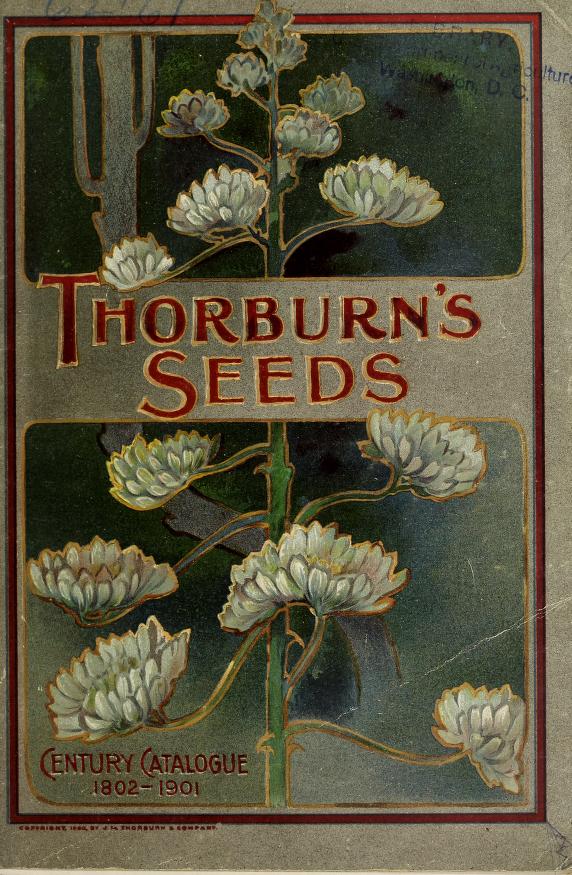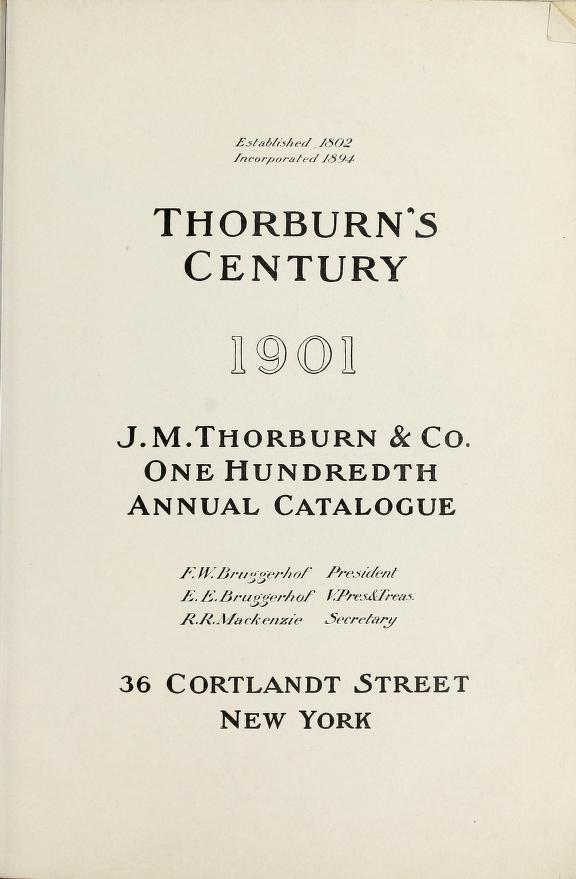
The New York Public Library Digital Collections. Map of Lower Manhattan 1902
It’s hard to imagine today that the urban streets of Lower Manhattan might once have had a connection with horticulture. But in the 19th and early 20th centuries the streets off Broadway were home to a network of highly successful seed merchants and companies offering services connected with domestic and commercial cultivation.
The Biodiversity Heritage Library’s Seed and Nursery Catalog Collection preserves thousands of colourful illustrated seed catalogues from companies across the United States, revealing which crops and flowers were popular in the past, and the locations where companies were based. Many merchants, justifiably proud of their warehouse buildings and growing fields, described and illustrated them in their promotional literature.
In Manhattan, Burnett Brothers and Weeber & Don, both seed merchants and growers, were based in Chambers Street. In nearby Barclay Street were J.M. Thorburn & Co founded in 1802, and Stumpp & Walter who specialised in flower and vegetable seed (and beautiful catalogues). Dey Street was home to William Elliot & Sons Seedsmen and the retail premises of Peter Henderson and Co was in Cortlandt Street.
This list is by no means comprehensive, but gives some indication of the concentration of horticultural businesses in this area of the city. All these companies sold seeds for domestic use and supplied wholesale grains and vegetable seeds to farmers. Most sold grass seed for lawns and sports uses, garden tools, machinery, fertilisers and pesticides.
Henderson’s catalogues give some idea of the size of this particular business. The illustrations below from 1905 show the five storey retail premises in Cortlandt Street plus the seed processing, packing and storage warehouses in Jersey City. Also shown are acres of greenhouses in Arlington Avenue in Jersey City, then a centre for market gardening.
Peter Henderson wrote articles about gardening for magazines and published his first book explaining how to run a market gardening business Gardening for Profit in 1866. Gardening for Pleasure (1875) was aimed at the amateur gardener and explains how to grow flowers, fruit and vegetables. Henderson’s catalogues represented a significant part of the company’s marketing strategy, with 750,000 printed every January in the 1880s.
The company remained in family hands until the mid 1940s, but failed to move with the times. An article in Life Magazine described employees in the Cortlandt Street store using the same scales to weigh out seeds that had been used in the 19th century, and ladies filling flower seed packets ‘using little ivory measuring spoons of different sizes for different-sized seeds.’ Henderson merged with Stumpp & Walter in 1951, but by 1953 this company had closed.
William Elliott’s catalogue of 1897 reveals an advertisement for Hitchings & Co, suppliers of glasshouses and heating systems for these structures – another contributor to the local horticultural industry. In the late 19th century Hitchings & Co was based in Mercer Street. The New York Botanical Garden records that this company was established in 1844, beginning as a specialist in the manufacture of ventilation and heating systems for greenhouses, and that it began making greenhouse structures in 1888.
These vividly coloured catalogues must have been an inspiration to gardeners when they were published and remain full of interest today, showing the scale and importance of the horticultural industry and the contribution it made to New York.

This image shows the Peter Henderson Co’s retail premises in Manhattan (centre) and the seed packing premises in Jersey City. From Everything for the Garden 1905. Peter Henderson & Co.

Everything for the Garden Peter Henderson & Co 1916. Showing acres of glasshouses and cultivation fields in New Jersey supplying the business with seeds, bulbs, tubers, etc.

Everything for the Garden 1910

Everything for the Garden 1910

Everything for the Garden 1916

Everything for the Garden 1916

Everything for the Garden 1916

Stumpp & Walter, Spring 1912

Stumpp & Walter, Spring 1912

Peter Henderson Stumpp & Walter Co Fall catalogue 1951 shortly after the companies merged.

Peter Henderson Stumpp & Walter Co Fall catalogue 1951 announcement of the merger of the two companies.

Wm Elliott & Sons 1897

Wm Elliott & Sons 1897

Wm Elliott & Sons 1897

Burnett Brothers, seedsmen 1918

Burnett Brothers, seedsmen 1918

Weeber & Don, seed merchants and growers 1919

Weeber & Don, seed merchants and growers 1919 – showing detail of the company’s building on Chambers Street, New York

Thorburn’s century: J. M. Thorburn & Co one hundredth annual catalogue 1901

Thorburn’s century: J. M. Thorburn & Co one hundredth annual catalogue 1901

MacNiff Horticultural Company Seed Annual 1921

Further reading:
Biodiversity Heritage Library Seed Catalogs


































